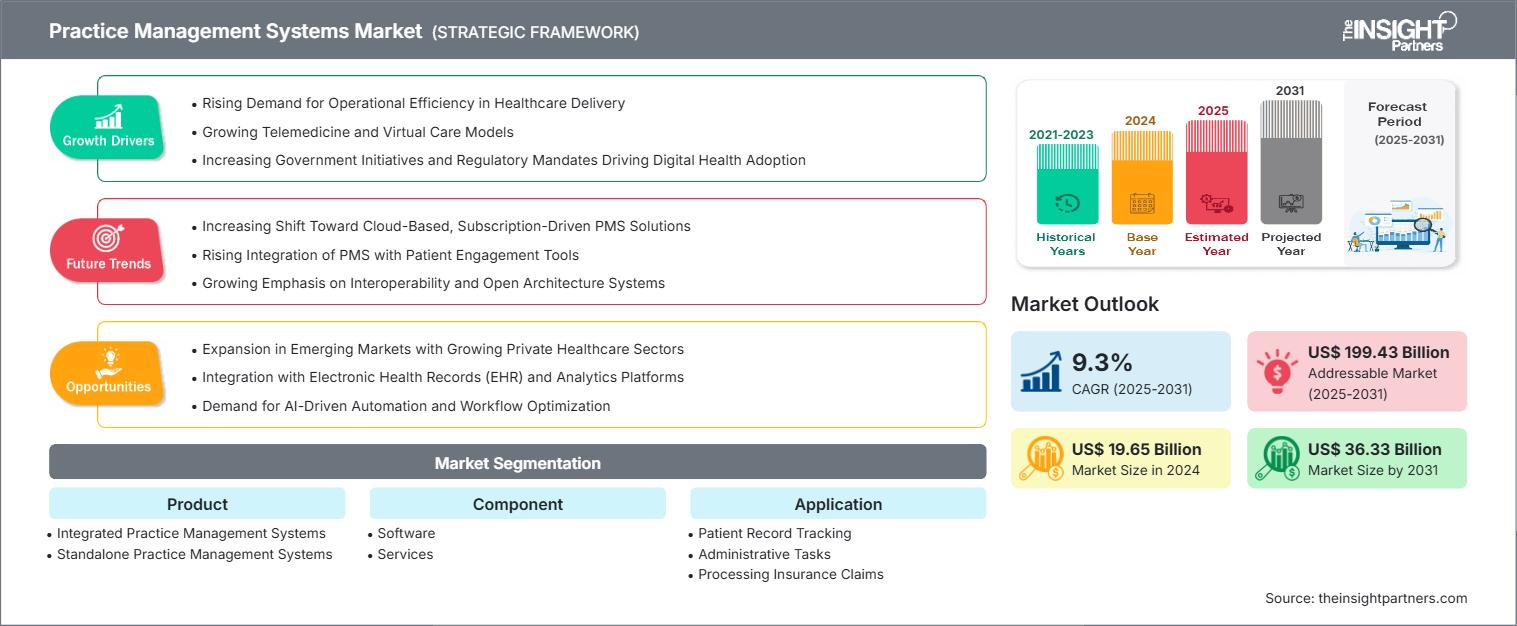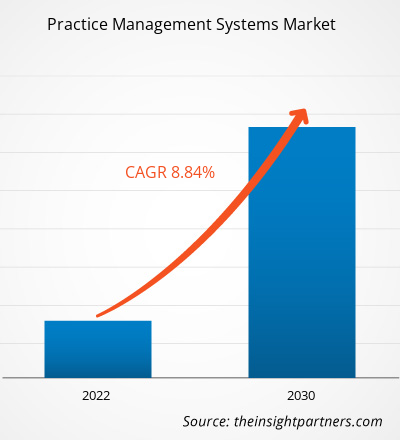Der Markt für Praxismanagementsysteme soll von 19,65 Milliarden US-Dollar im Jahr 2024 auf 36,33 Milliarden US-Dollar im Jahr 2031 anwachsen. Für den Markt wird zwischen 2025 und 2031 eine durchschnittliche jährliche Wachstumsrate (CAGR) von 9,3 % erwartet.
Marktanalyse für Praxismanagementsysteme
Die Marktprognose für Praxismanagementsysteme deutet auf Wachstum hin. Dies ist auf die umfassende Digitalisierung der Gesundheitssysteme, effiziente Ressourcennutzung und Kosteneinsparungen sowie steigende regulatorische und erstattungsbezogene Compliance-Anforderungen zurückzuführen. Die Marktexpansion wird durch die Kompatibilität mit Telemedizin- und Fernüberwachungssystemen, KI-gestützte Datenanalyse und staatliche Anreize für die Nutzung digitaler Gesundheitsdienste erleichtert. Darüber hinaus fördert die Umstellung auf Cloud- und integrierte PMS-Lösungen, die die Patientenabrechnung und die Bearbeitung von Versicherungsansprüchen vereinfachen, das Marktwachstum.
Marktübersicht für Praxismanagementsysteme
Praxismanagementsysteme (PMS) sind notwendige Software, die die administrativen und operativen Abläufe in Arztpraxen vereinfacht und automatisiert. Das System erleichtert die effiziente Verwaltung von Terminplanung, Abrechnung, Patientenakten, Versicherungsansprüchen und Arbeitsabläufen in verschiedenen medizinischen und verwandten Gesundheitsumgebungen. Durch Effizienzsteigerung, reduzierten Papierkram und die Förderung der Patienteneinbindung ermöglichen PMS-Lösungen Gesundheitsdienstleistern, mehr Zeit für die klinische Versorgung zu haben und gleichzeitig die Einhaltung von Vorschriften und finanzielle Stabilität zu gewährleisten.
Sie erhalten kostenlos Anpassungen an jedem Bericht, einschließlich Teilen dieses Berichts oder einer Analyse auf Länderebene, eines Excel-Datenpakets sowie tolle Angebote und Rabatte für Start-ups und Universitäten.
Markt für Praxismanagementsysteme: Strategische Einblicke

-
Holen Sie sich die wichtigsten Markttrends aus diesem Bericht.Dieses KOSTENLOSE Beispiel umfasst Datenanalysen, die von Markttrends bis hin zu Schätzungen und Prognosen reichen.
Markttreiber und Chancen für Praxismanagementsysteme
Markttreiber:
- Steigende Nachfrage nach betrieblicher Effizienz in der Gesundheitsversorgung: Gesundheitsorganisationen verzeichnen einen Massenzustrom von Patienten, wobei komplizierte Prozesse und Kostensteigerungen große Herausforderungen darstellen.
- Wachsende Telemedizin und virtuelle Pflegemodelle: Der weltweite Übergang zur digitalen Gesundheitsversorgung hat den Umfang von PMS erheblich erweitert.
- Zunehmende Regierungsinitiativen und Regulierungsauflagen fördern die Einführung digitaler Gesundheitslösungen: PMS gehören zu einer Vielzahl von IT-Lösungen für das Gesundheitswesen, deren flächendeckende Implementierung von Regierungen weltweit aktiv unterstützt wird.
Marktchancen:
- Expansion in Schwellenmärkten mit wachsendem privaten Gesundheitssektor: In Schwellenmärkten wie Indien, China und Brasilien werden aufgrund des expandierenden privaten Gesundheitssektors und steigender Investitionen in die Gesundheits-IT zunehmend Praxismanagementsysteme eingesetzt.
- Integration mit elektronischen Gesundheitsakten (EHR) und Analyseplattformen: Die Integration von PMS mit EHR-Systemen und ausgefeilter Analyse führt zu nahtlosem Datenmanagement und sofortigen Erkenntnissen.
- Nachfrage nach KI-gesteuerter Automatisierung und Workflow-Optimierung: Der Trend zur Digitalisierung im Gesundheitswesen und zur intelligenten Gesundheitsinfrastruktur ist der Haupttreiber der Nachfrage nach KI-gestützten PMS-Lösungen.
Segmentierungsanalyse des Marktberichts zu Praxismanagementsystemen
Der Marktanteil von Praxismanagementsystemen wird segmentübergreifend analysiert, um ein besseres Verständnis der Struktur, des Wachstumspotenzials und der neuen Trends zu ermöglichen. Nachfolgend finden Sie den Standardsegmentierungsansatz, der in den meisten Branchenberichten verwendet wird:
Nach Produkt:
- Integrierte Praxismanagementsysteme: Integrierte Praxismanagementsysteme (IPMS) sind die Kombination dreier Funktionen: administrativer, klinischer und finanzieller Art, die nahtlos zusammengeführt werden, um es den Gesundheitsdienstleistern zu ermöglichen, ihre Abläufe zu rationalisieren, die Patientenversorgung zu verbessern und das Umsatzzyklusmanagement effizient zu gestalten.
- Eigenständige Praxisverwaltungssysteme: Eigenständige Praxisverwaltungssysteme (PMS) sind auf die spezifischen Anforderungen des Marktes für Praxisverwaltungssysteme zugeschnitten und bieten zentrale Verwaltungsfunktionen wie Terminplanung, Abrechnung und Patientenregistrierung, ohne auf klinische Systeme wie elektronische Gesundheitsakten (EHRs) zuzugreifen.
Nach Komponente:
- Software: Das Softwaresegment des Marktes für Praxismanagementsysteme (PMS) bildet die Basis des gesamten Marktökosystems. Verschiedene digitale Lösungen unterstützen Gesundheitspraxen bei der Automatisierung und Vereinfachung ihrer administrativen und finanziellen Abläufe.
- Dienstleistungen: Der Dienstleistungsbereich ist für die erfolgreiche Implementierung, Optimierung und den laufenden Betrieb von PMS-Softwarelösungen von entscheidender Bedeutung.
Nach Liefermodus:
- Webbasierte Praxismanagementsysteme: Webbasierte PMS sind die ausgereifteste und am weitesten verbreitete Anwendung im Bereich Praxismanagement, um den Arbeitsablauf der verschiedenen Gesundheitsteams einfach und effizient zu verwalten.
- Cloudbasierte Praxismanagementsysteme: Gesundheitsdienstleister können cloudbasierte PMS verwenden, um über eine skalierbare und anpassbare Infrastruktur zu verfügen.
- Praxismanagementsysteme vor Ort: Mithilfe von PMS-Lösungen vor Ort können Gesundheitsdienstleister den Patientenfluss, die Finanzzyklen und die allgemeine Praxisleistung mithilfe umfassender Tracking- und Verwaltungsfunktionen genau überwachen.
Durch Endbenutzer:
- Krankenhäuser und Kliniken
- Arztpraxis
- Versicherungsgesellschaften
- Sonstige
Jeder Sektor hat spezifische Anforderungen an Praxismanagementsysteme. Dies beeinflusst das Datenmanagement und die Datenanalyse.
Nach Geografie:
- Nordamerika
- Europa
- Asien-Pazifik
- Süd- und Mittelamerika
- Naher Osten und Afrika
Der Markt für Praxismanagementsysteme im asiatisch-pazifischen Raum wird im Prognosezeitraum voraussichtlich das schnellste Wachstum verzeichnen, angetrieben durch die schnelle Digitalisierung des Gesundheitswesens in Ländern wie China, Indien und Japan.
Regionale Einblicke in den Markt für Praxismanagementsysteme
Die Analysten von The Insight Partners haben die regionalen Trends und Faktoren, die den Markt für Praxismanagementsysteme im Prognosezeitraum beeinflussen, ausführlich erläutert. In diesem Abschnitt werden auch die Marktsegmente und die geografische Lage in Nordamerika, Europa, dem asiatisch-pazifischen Raum, dem Nahen Osten und Afrika sowie Süd- und Mittelamerika erörtert.
Umfang des Marktberichts zu Praxismanagementsystemen
| Berichtsattribut | Details |
|---|---|
| Marktgröße im Jahr 2024 | 19,65 Milliarden US-Dollar |
| Marktgröße bis 2031 | 36,33 Milliarden US-Dollar |
| Globale CAGR (2025 – 2031) | 9,3 % |
| Historische Daten | 2021–2023 |
| Prognosezeitraum | 2025–2031 |
| Abgedeckte Segmente |
Nach Produkt
|
| Abgedeckte Regionen und Länder |
Nordamerika
|
| Marktführer und wichtige Unternehmensprofile |
|
Dichte der Marktteilnehmer für Praxismanagementsysteme: Verständnis ihrer Auswirkungen auf die Geschäftsdynamik
Der Markt für Praxismanagementsysteme wächst rasant. Die steigende Nachfrage der Endnutzer ist auf Faktoren wie veränderte Verbraucherpräferenzen, technologische Fortschritte und ein stärkeres Bewusstsein für die Produktvorteile zurückzuführen. Mit der steigenden Nachfrage erweitern Unternehmen ihr Angebot, entwickeln Innovationen, um den Bedürfnissen der Verbraucher gerecht zu werden, und nutzen neue Trends, was das Marktwachstum weiter ankurbelt.

- Überblick über die wichtigsten Akteure auf dem Markt für Praxismanagementsysteme
Marktanteilsanalyse für Praxismanagementsysteme nach Geografie
Der asiatisch-pazifische Raum dürfte in den kommenden Jahren am stärksten wachsen. Auch die Schwellenmärkte in Süd- und Mittelamerika, dem Nahen Osten und Afrika bieten Anbietern von Praxismanagementsystemen zahlreiche ungenutzte Expansionsmöglichkeiten.
Der Markt für Praxismanagementsysteme weist in jeder Region eine unterschiedliche Wachstumskurve auf. Diese wird durch Faktoren wie die Gesundheitsinfrastruktur, das regulatorische Umfeld, die Einführung digitaler Gesundheitslösungen und staatliche Initiativen bestimmt. Nachfolgend finden Sie eine Übersicht über Marktanteile und Trends nach Regionen:
1. Nordamerika
- Marktanteil: Hält den größten Marktanteil aufgrund der fortschrittlichen Gesundheitsinfrastruktur und der frühen digitalen Einführung.
-
Haupttreiber:
- Weit verbreitete EHR/EMR-Integration
- Einhaltung gesetzlicher Vorschriften (z. B. HIPAA, MACRA)
- Hohe Nachfrage nach Revenue Cycle Management (RCM)-Tools
- Trends: Umstellung auf Cloud-basiertes PMS und Telemedizin-Integration zur Optimierung administrativer Arbeitsabläufe und der Fernversorgung.
2. Europa
- Marktanteil: Öffentliche Gesundheitssysteme und strenge Richtlinien zur Datenverwaltung sorgen für einen erheblichen Marktanteil.
-
Haupttreiber:
- DSGVO-konforme Software-Nachfrage
- Digitalisierungsprojekte des National Health Service (NHS)
- Wachsender Bedarf an Effizienz in Praxen mit mehreren Fachrichtungen
- Trends: Zunehmende Nutzung interoperabler PMS-Plattformen zur Unterstützung des grenzüberschreitenden Austauschs von Gesundheitsdaten und einer einheitlichen Gesundheitsversorgung.
3. Asien-Pazifik
- Marktanteil: Am schnellsten wachsende Region aufgrund der schnellen Digitalisierung des Gesundheitswesens und des wachsenden Medizintourismus.
-
Haupttreiber:
- Staatlich geförderte IT-Initiativen im Gesundheitswesen
- Anstieg privater Gesundheitsdienstleister
- Steigende Patientenzahlen und steigende Nachfrage nach städtischer Gesundheitsversorgung
- Trends: Einführung von KI-gesteuerten PMS für Terminplanung, Rechnungsautomatisierung und Sprachlokalisierungsfunktionen.
4. Süd- und Mittelamerika
- Marktanteil: Aufstrebender Markt mit zunehmender Akzeptanz digitaler Gesundheitsdienste.
-
Haupttreiber:
- Öffentlich-private Gesundheitspartnerschaften
- Notwendigkeit administrativer Effizienz in unterfinanzierten Systemen
- Ausbau privater Kliniken und Fachzentren
- Trends: Cloudbasierte, kostengünstige PMS-Lösungen gewinnen an Bedeutung, insbesondere bei kleinen und mittleren Gesundheitsdienstleistern.
5. Naher Osten und Afrika
- Marktanteil: Entwicklungsmarkt mit starkem Wachstumspotenzial aufgrund steigender Investitionen im Gesundheitswesen.
-
Haupttreiber:
- Nationale E-Health-Strategien
- Ausbau der Gesundheitsinfrastruktur
- Steigende Nachfrage nach Automatisierung in Arztpraxen
- Trends: Implementierung von PMS in integrierten Versorgungsmodellen, einschließlich Primärversorgung, Facharztversorgung und Diagnosediensten – oft als Teil umfassenderer Gesundheitsinformationssysteme
Dichte der Marktteilnehmer für Praxismanagementsysteme: Verständnis ihrer Auswirkungen auf die Geschäftsdynamik
Hohe Marktdichte und Wettbewerb
Der Wettbewerb verschärft sich aufgrund der Präsenz großer Anbieter wie GE HealthCare Technologies Inc., Athenahealth Inc. und WRS Health. Regionale und Nischenanbieter wie MEDITECH (Nordamerika) tragen ebenfalls zur Marktdichte bei.
Dieses Wettbewerbsumfeld zwingt die Anbieter dazu, sich durch Folgendes zu differenzieren:
- Nahtlose Integration mit elektronischen Gesundheitsakten (EHR) und Telemedizin-Plattformen
- Skalierbare, Cloud-basierte PMS-Lösungen, zugeschnitten auf kleine Praxen und große Gesundheitsnetzwerke
- KI-gestützte Automatisierung für Terminplanung, Abrechnung und Kodierungsgenauigkeit
- Interoperabilität mit Systemen von Drittanbietern, einschließlich Laboren, Apotheken und Versicherungsanbietern
Chancen und strategische Schritte
- Arbeiten Sie mit Gesundheitsdienstleistern und öffentlichen Gesundheitssystemen zusammen, um die digitale Transformation und die Optimierung von Arbeitsabläufen zu unterstützen
- Integrieren Sie KI/ML für das Umsatzzyklusmanagement, die Patienteneinbindung und die Betriebsprognose.
Die wichtigsten Unternehmen auf dem Markt für Praxismanagementsysteme sind:
- GE HealthCare Technologies Inc, Vereinigte Staaten
- Athenahealth Inc., Vereinigte Staaten
- WRS Health, Vereinigte Staaten
- Veradigm Inc., Vereinigte Staaten
- Greenway Health LLC, Vereinigte Staaten
- McKesson Corp, Vereinigte Staaten
- NextGen Healthcare Inc., Vereinigte Staaten
- MEDITECH, Vereinigte Staaten
- CERTIFY Health, Vereinigte Staaten
- eClinicalWorks LLC, Vereinigte Staaten
Haftungsausschluss: Die oben aufgeführten Unternehmen sind nicht in einer bestimmten Reihenfolge aufgeführt.
Weitere im Rahmen der Untersuchung analysierte Unternehmen:
- OmniMD Henry Schein, Inc.
- AdvantEdge Healthcare-Lösungen
- Cerner Corporation (Oracle)
- Epic Systems Corporation
- Accumedic Computer Systems, Inc.
- NXGN Management, LLC
- CoreCloud
- Kareo, Inc.
- Practice Fusion, Inc.
- AdvancedMD, Inc.
- DrChrono, Inc.
- CollaborateMD Inc.
- OfficeAlly Inc.
- PracticeSuite Inc.
Marktnachrichten und aktuelle Entwicklungen zu Praxisverwaltungssystemen
- eClinicalWorks, das größte ambulante Cloud-EHR-System, gab bekannt, dass South Lake Pediatrics, eine bekannte arztgeführte Kinderarztpraxis in Minnesota, Sunoh.ai, einen KI-gestützten medizinischen Schreiber, nutzt, um die Effizienz der klinischen Dokumentation zu verbessern.
- GE HealthCare (Nasdaq: GEHC) führt die Liste der US-amerikanischen Food and Drug Administration (FDA) für die Zulassung von KI-gestützten Medizinprodukten das vierte Jahr in Folge an. Mit bisher 100 Zulassungen in den USA steht GE HealthCare (Nasdaq: GEHC) das vierte Jahr in Folge an der Spitze der Liste der US-amerikanischen Food and Drug Administration (FDA) für die Zulassung von KI-gestützten Medizinprodukten. Dieser Meilenstein spiegelt die kontinuierlichen Investitionen und Entwicklungen von GE HealthCare wider. Der Schwerpunkt liegt auf der Entwicklung von KI-Lösungen zur Förderung der Präzisionsversorgung durch die Verbesserung medizinischer Geräte über den gesamten Behandlungsverlauf hinweg. Intelligente Geräte, Software und Cloud-basierte Lösungen, die für die Präzisionsversorgungsstrategie von GE HealthCare von zentraler Bedeutung sind, tragen dazu bei, die Behandlungsergebnisse der Patienten zu verbessern, die tägliche Arbeit der Pflegeteams zu erleichtern und die Effizienz des medizinischen Fachpersonals zu steigern.
Marktbericht zu Praxismanagementsystemen – Umfang und Ergebnisse
Der Bericht „Marktgröße und Prognose für Praxismanagementsysteme (2021–2031)“ bietet eine detaillierte Analyse des Marktes, die die folgenden Bereiche abdeckt:
- Marktgröße und Prognose für Praxismanagementsysteme auf globaler, regionaler und Länderebene für alle wichtigen Marktsegmente, die im Rahmen des Berichts abgedeckt sind
- Markttrends und Marktdynamiken im Bereich Praxismanagementsysteme wie Treiber, Einschränkungen und wichtige Chancen
- Detaillierte PEST- und SWOT-Analyse
- Marktanalyse für Praxismanagementsysteme mit wichtigen Markttrends, globalen und regionalen Rahmenbedingungen, wichtigen Akteuren, Vorschriften und aktuellen Marktentwicklungen
- Branchenlandschafts- und Wettbewerbsanalyse mit Marktkonzentration, Heatmap-Analyse, prominenten Akteuren und jüngsten Entwicklungen auf dem Markt für Praxismanagementsysteme
- Detaillierte Firmenprofile
- Historische Analyse (2 Jahre), Basisjahr, Prognose (7 Jahre) mit CAGR
- PEST- und SWOT-Analyse
- Marktgröße Wert/Volumen – Global, Regional, Land
- Branchen- und Wettbewerbslandschaft
- Excel-Datensatz
Aktuelle Berichte
Verwandte Berichte
Erfahrungsberichte
Grund zum Kauf
- Fundierte Entscheidungsfindung
- Marktdynamik verstehen
- Wettbewerbsanalyse
- Kundeneinblicke
- Marktprognosen
- Risikominimierung
- Strategische Planung
- Investitionsbegründung
- Identifizierung neuer Märkte
- Verbesserung von Marketingstrategien
- Steigerung der Betriebseffizienz
- Anpassung an regulatorische Trends






















 Kostenlose Probe anfordern für - Markt für Praxismanagementsysteme
Kostenlose Probe anfordern für - Markt für Praxismanagementsysteme